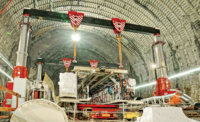Roof construction of the $720 million London 2012 Olympic stadium began in late January when the first section went up and the Olympic Delivery Authority claims to be on track. All venues in the east London Olympic Park are on schedule, claims ODA.
But the global banking crisis is spoiling its party. The ODA can’t secure as much private funding towards the $13.3 billion overall construction budget as forecast.

The Olympic Village, a public private partnership, is worst hit. Funding negotiations for Village construction with Australia-based Lend Lease Corporation “are continuing,” says ODA Chief Executive David Higgins.
Lend Lease leads a consortium selected last year to partially finance and develop the Village, including 11 groups of five to seven residential buildings. The consortium has struggled to raise sufficient debt, forcing the Department for Culture, Media and Sport to step in.
To compensate for the Village’s funding shortfall, DCMS in January allocated $316 million from the Games’s overall construction contingency, on top of $136 million released last year.
Of the original $3.9 billion contingency, $2.1 billion remains. But falling construction inflation has helped keep the budget unchanged, claims Olympics Minister Tessa Jowell.
On site, ODA claims to be hitting all key milestones. The stadium climbed to roof level at the end of last month (January) when the first 30 m long, 85 tonne piece of steelwork was craned 37 m up into place.
It was the first of 28 assemblies that will form a compression ring around the stadium’s perimeter, by this October. Cables stressed to this ring will support a roof, extending 28 m from the edge to cover two thirds of the spectators.
Part of a design/build contract, the stadium will have 25,000 permanent seats and another 55,000 for the big ceremonies. A consortium including the contractor Sir Robert McAlpine Ltd., structural firm Buro Happold and architect HOK Sport clinched the stadium contract from ODA in mid-2007.


